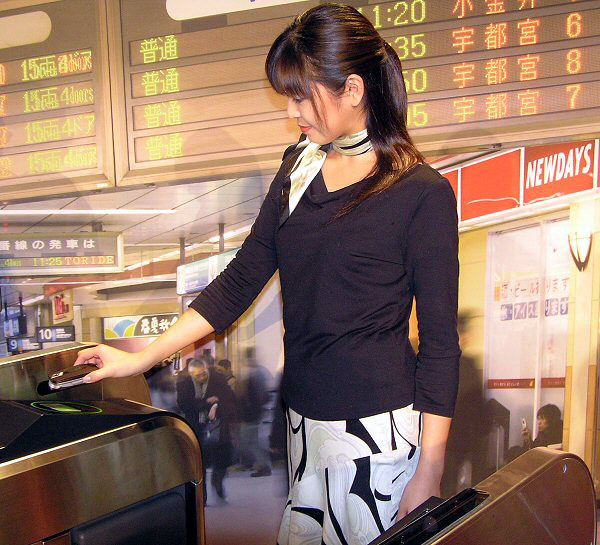10th Anniversary of Mobile NFC in Japan
 On June 16th 2004 DoCoMo held a press conference at the Teikoku Hotel to introduce the world first commercial launch of NFC enabled mobile phones. While the 10th anniversary is coming up next week, we have not seen anything about it (yet), suppose that’s why you love us.. as we’ve always been ‘just slightly’ ahead of the curve.
On June 16th 2004 DoCoMo held a press conference at the Teikoku Hotel to introduce the world first commercial launch of NFC enabled mobile phones. While the 10th anniversary is coming up next week, we have not seen anything about it (yet), suppose that’s why you love us.. as we’ve always been ‘just slightly’ ahead of the curve.
I’m a bit slammed for time, our client projects work is always my top priority, but I really do want to get a few thoughts out on this thread. We had covered the initial DCM trial debut, in December 2003, however July 2004 was an official four model roll-out (only 1 of them 3G!) to the public at large here. The domestic market was already well-established with card-type Tap & Go for payments, so predictable addition to handsets with screen display and internet connection had finally arrived, that iconic event marked a natural evolution of mobile in Japan. FeliCa Networks was incorporated in January of 2004 with current shareholding structure at 57% Sony, 38% DoCoMo and 5% by East Japan Railway with records stating 236 Million total aggregate “Mobile” FeliCa chips shipped to-date. The P506iC went on sale July 10th, 2004.
For starters perhaps a good idea to clear-up some standard misconceptions; such as usual “FeliCa is not really NFC” and that’s just another “weird Japan” thing. Looking at the global industry association NFC Forum, and Yes, Tagawa-san is still Chairman, their defined spec. is noted quite clearly. Regardless of the intricate Type A/B etc. standards, with ISO awarded or otherwise, the Sony solution is certainly NFC(.) I might also add it’s comparatively superior in both speed and security while indeed that result comes with a slight premium attached. As for the ‘cultural’ aspect, and we’ve said it countless times here over the years: it’s really the Business Model that’s unique.. not the end users. There are So Many examples of ‘people are people’ (from London to New York to Tokyo), if you provide them a valuable offering they will generally respond in the same way. Obviously there are issues in other markets surrounding regulations with respect to telecoms and banking or sales channel distribution of handsets vs. Japanese operators build to order approach. Simply put: it’s proven, at scale, for a decade.
A few more generic points we (still) see via comments from overseas:
What if I lose my phone?
– At least you can remotely lock it, what happens if you lose your wallet.. @_@
What if my battery dies?
– Transactions are powered by point of sale reader, no battery in NFC card-style.
How do I access money?
– In Japan there are four ways: Direct connect to bank account or credit card (requires pin), incremental amount top-ups from either of aforementioned accounts, carrier pre-approved limit with transactions settled via your monthly bill or add cash credit value at any location with point of sale reader that can debit (7-11 etc).
So, where are we after 10 years? A typical challenge to get good numbers, best effort figures indicate +90 Million active NFC handsets in Japan with 1.8 Million point of sale locations. One well-placed source has indicated weekly active users are hovering just above the 30% ratio, of course it would be great to know those daily and monthly numbers too. Further ‘nice to have’ dark data would be: what is the annual gross, net and the average spend of all mobile NFC clients in Japan – good luck with that, a safe bet it’s worth alot of cupcakes!
Now, 3 quick points going forward. Let’s get the gorilla in the room out of the way first: Apple. Will they pull the trigger.. of course, it’s not If but When and as usual most important – How? Lots of chatter about BLE, but many might consider that pre-Y2K tech developed by Nokia to be somewhat less than ideal for secure privacy and financial transactions. Interesting side note related, Aplix has just announced an interim solution. On the global side of getting NFC firmly established, as we’ve mentioned in the past: Boys Need Girls. While having critical mass device adoption is increasingly evident with low-cost per unit for the hardware, all those handsets need enabled POS locations at scale in order to actually engage. Finally, as we move towards a next-gen. connected world of sensors and wearables, this quick, unique and secure data exchange of 1’s and 0’s will ultimately become (cough *Camera-Phone* cough) a natural and universal part of your daily life.
Whew, 700 words and no lunch-break for me, Yoroshiku!
Filed Under: Editors Note

